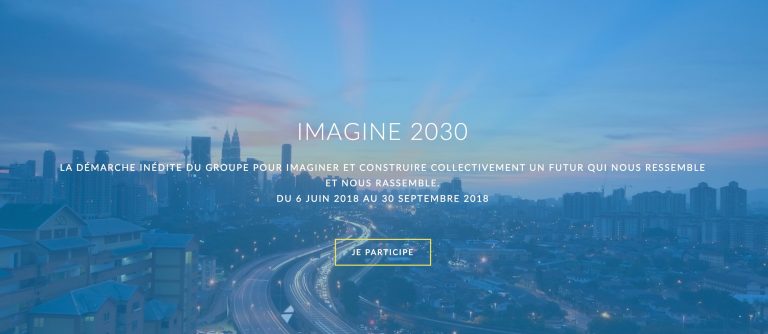In order to step away from the all-around POCs that lead nowhere and do not always allow the team to join in as a whole, here are 7 actions to be carried out by the Innovation Department to mobilize start-ups and employees in a sustainable way.
In 2019, reducing the cycle from idea to industrialization will remain the key challenge for Innovation Departments that do not want to be confined to becoming “POC machines”. Another challenge in this gloomy and pessimistic French context will be how the Innovation Department can contribute to wooing once again the organisation’s stakeholders(employees, customers, startups, etc.) into partnerships with startups, intrapreneurship and the co-creation of new offers? Finally, since agile methods have infused new ways of working, how can their application to several thousand participants be scaled up over short cycles in innovation processes? Finally, how can we rely on digital innovation and collective intelligence to accelerate everything?
Here are 7 concrete actions to complete the roadmap of the Innovation Departments in 2019 in order to meet the following challenges: reduce the innovation cycle by involving as many people as possible and ensuring that the entire organization takes ownership of it, reactivate the creative capacity of employees or customers by using an innovative and resolutely utopian Design Fiction format, and build on the wave of citizen consultation to mobilize even more stakeholders in the ecosystem.
1. Successful acquisition and integration of a startup through collective intelligence
As we all know, and all too well, large groups most often kill a startup (or an SME) and the benefits expected, once the transaction is completed, by its structural and cultural inability to integrate and sublimate synergies. Imagine that a major online debate invites all the group’s employees to co-construct an action plan on the theme “How to successfully integrate the startup X to contribute to our strategic plan?” A three-pronged home-run: a communication and awareness plan for everyone on the acquisition (showing that everything remains to be done in all humility), a community mobilized to accelerate and succeed in integration and boost synergies, a startup team impressed by the collaborative culture of the large group that hosts them.
2. Co-construct the group’s intrapreneurship program… with interested parties
That is to say with all employees! It makes sense, but it is not done: in general, we create programs in project mode, certainly with a minimum of collaboration, but never with the massive and concerted dimension that such a program deserves. A debate to be organised with all employees would be very relevant on topics such as: the eligibility process, support modalities (technical, HR, etc.), innovative areas to be addressed, key success factors and risks in the launch and implementation, the process and key stages of a typical project, etc. And if the intrapreneurship program already exists, it is a great opportunity to update it in collective intelligence mode, todefine its 2020 roadmap for example.
3. Co-construct its 2019/2022 innovation roadmap to several thousand in three months
There is nothing better than to involve each subsidiary, department, entity and employee in the co-construction of the innovation roadmap and its priority projects in order to develop a culture of innovation and ownership by everyone of the challenge of innovating on a daily basis, whatever their profession or activity.
4. Identify your five areas of rupture thanks to collective intelligence
Innovation Departments have often developed a number of POCs in recent years and are no longer sure they are consistent with the major areas that could disrupt their company’s sector. Moreover, this work of identifying and validating these major areas has most of the time not been done: ask top managers to name them and you will see that they often cannot do so nor are even able to agree on what they are. A collective intelligence approach to define them would not only have the advantage of raising awareness of these issues among most of the organization, but would also give the Innovation Department the relevant reference framework to manage its portfolio of projects, internal POCs or partnerships with start-ups, and to monitor its progress.
5. Organize an internal reverse innovation competition
The Objective? Reduce the cycle from idea to industrialization. One of the problems with innovation competitions (or challenges) that mobilize intrapreneurial employees is that their projects, even winning projects, have little support and little ownership from the rest of the organization at this stage. A lack that will prove destructive at the most crucial of times, the move from the POC to industrialization. So how can we keep the advantages of a dynamic call for talent to drive innovative projects, while simultaneously increasing the support of all departments (Marketing, HR, IT, Finance, etc.) as soon as possible? Rather, it is a question of launching a collective intelligence process on a certain number of strategic themes and bringing out a series of new projects co-created by all, then calling on talents to support them. This dynamic is thus a guarantee of the long-awaited induced acceleration to move from the idea to industrialization.
6. Define inspiring and uniquely insightful scenarios for a positive future
In the form of short storties written by employees (or customers/citizens) to involve the teams by revealing their talents as writers and storytellers. See the example of the debate ‘Cities & Territories of Tomorrow’ of the Ministry of Ecological and Solidarity Transition, which went so far as to publish the 12 best stories (“Citizen Booklets”) from their BrightMirror workshops in the form of a comic strip .
7. Involve clients/consumers in a social issue related to the brand during a citizen debate.
In an era where societal issues (ecology and respect for the environment, education, energy transition, circular economy, etc.) are increasingly inseparable from any new product or service (developed in a design spirit), it is also a question of innovating in the way we interact with our clients/consumers who expect to be consulted using the same methods and tools as those used to mobilize citizens (discussion forums, conversations and interactions between participants, etc.) rather than traditional marketing approaches (closed questionnaires, focus groups, etc.).



